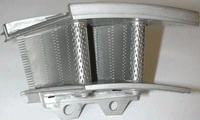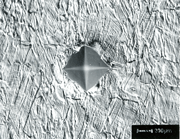Thermal spray processes like air plasma spray and High-Velocity Oxygen Fuel (HVOF) are usually thought of as being used primarily for applying protective coatings to new parts. While new part applications do indeed constitute the majority of their use, there are also a wide variety of repair techniques that employ thermal spray processes. VAC AERO has been a leader in developing repairs for aircraft structural components and gas turbine engine parts using thermal spray processes. An example of a structural component repair involves a flap track from a popular turboprop aircraft. As the wing flaps of this aircraft are extended and retracted during landing and take-off, rollers run along the surfaces of a series of components known as flap tracks.
An example of a structural component repair involves a flap track from a popular turboprop aircraft. As the wing flaps of this aircraft are extended and retracted during landing and take-off, rollers run along the surfaces of a series of components known as flap tracks. For the original flap track design, the manufacturer applied a nickel-based electroplated coating to protect the roller wear surfaces. However, after a certain period of service, the electro-plated coating was worn away and significant wear also occurred in the base metal substrate beneath. VAC AERO was tasked with coming up with a method of re-building the worn substrate and applying a more durable coating to the wear surfaces. VAC AERO’s solution was to use the HVOF process to apply a tungsten carbide coating over the worn area. This coating was used for both the restoration of the damaged substrate and as a wear resistant overlay. Because this application requires high bond strength and fatigue resistance, several coating compositions were tested before the ideal candidate emerged. The development of the proper spray parameters also required significant effort to ensure the coating adhered properly, particularly where it “feathered” out at the edges of the overlay. VAC AERO’s repair technique was subsequently approved by the aircraft manufacturer.


